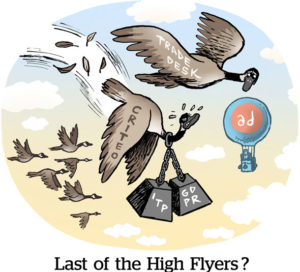 The Trade Desk reported Q3 revenue of $118.8 million, a 50% year-over-year increase.
The Trade Desk reported Q3 revenue of $118.8 million, a 50% year-over-year increase.
The company has maintained growth of 50% or more in the past two quarters, matching its growth rates from the same periods last year. With an upward revision to the company’s revenue forecast next quarter, CEO Jeff Green said he expects the company’s rate of growth to exceed that of Q4 2017.
“We’re very proud of that, given that we’re making much bigger numbers now,” Green said.
The Trade Desk is battling it’s own growth, in a sense, since its value doubled from November 2016 to November 2017 and more than doubled again in the past year. The company must sustain its growth momentum to validate that market cap – about $5.3 billion at close of trading Thursday.
Here are a few key areas where Green sees a path to preserving growth rates even as overall revenue increases.
The TV game
Connected TV (CTV) is the make or break category for The Trade Desk.
CTV will consume more product and operations investments than anything else next year, Green said. And the company’s 1,000% growth in CTV spending from Q3 last year remains his most bullish metric.
Advertisers want addressable TV, but CTV supply hasn’t taken off yet.
Some broadcasters left in the cold by skinny bundles have developed their own offerings on platforms like Roku and thus created programmatic CTV inventory, Green said. Though at the moment more inventory comes from the skinny bundle operators themselves – including Dish and AT&T’s DirecTV Now – which he said rely on programmatic to boost ad rates and make their tighter profit margins work.
The juiciest fruit has yet to ripen. Platforms like Hulu and the biggest broadcasters, even those with the most sophisticated data-driven platforms, still primarily sell ads via sales teams.
“That represents a tremendous opportunity for us,” Green said, as broadcasters cut costs and embrace data-driven automation.
The new landscape
The Trade Desk may stand to benefit from recent and ongoing changes to its competitive set.
Google: The big kahuna’s actions this year have signaled to the market that there is an internal deprioritization of its DSP business, “the artist formerly known as DoubleClick,” Green said.
Next year Google will stop allowing advertisers to extract the Google ad ID to measure campaigns across other platforms, a policy already in place in Europe since GDPR took effect in May. Google has also restricted more measurement and audience capabilities to the Ads Data Hub product, where insights can’t be extracted by a brand or agency.
This makes sense for Google, Green said, since its DSP and ad server are a fraction of the Search, YouTube and Google audience data budgets that are being defended with the new policies.
“Because the changes (with Google) are complicated and nuanced we’ve only scratched the surface of the benefits we’ll see from these policies,” he said.
Amazon: The ecommerce giant has stormed into ad tech in recent years and is now entrenched with Google as the second-most-used DSP in the market.
“But I worry about them less than Google or Facebook,” Green said.
As with Google and Facebook, everyone will work with Amazon, but brand marketers already feel overexposed to Amazon as an inventory source, sales channel, cloud and data storage provider and, often, direct competitor to a private-label product.
“Facebook got out of the DSP game in part because of that conflict and Amazon has a bigger objectivity problem than anyone on Earth,” he said.
With Fire TV, not to mention to Prime Video service, Amazon will be a significant player in the future of TV budgets, but Green said he expects that at that point Amazon will open up to broader programmatic demand.
AppNexus: The acquisition of AppNexus, The Trade Desk’s closest competitor among independent ad tech companies, creates a chance to seize market share with more sophisticated, API-based buyers.
“We have massively underinvested in selling and distributing our API product,” a part of the ecosystem where the company trailed AppNexus, Green said. But now AppNexus’s product roadmap will focus on TV and improving returns for AT&T’s WarnerMedia investment – not on staying fresh in programmatic development.
“You could make the argument that the stickiest customers are those that leverage and develop on your APIs,” Green said. And next year that will be the second-largest area of investment, he said, after CTV development.
This post was syndicated from Ad Exchanger.


More Stories
Comic: Working Hard or Hardly Working?
NZME celebrates 2024 Voyager Media Awards nominations
Squeezing Innovation: CEO Monica McGurk’s Fresh Take at Tropicana